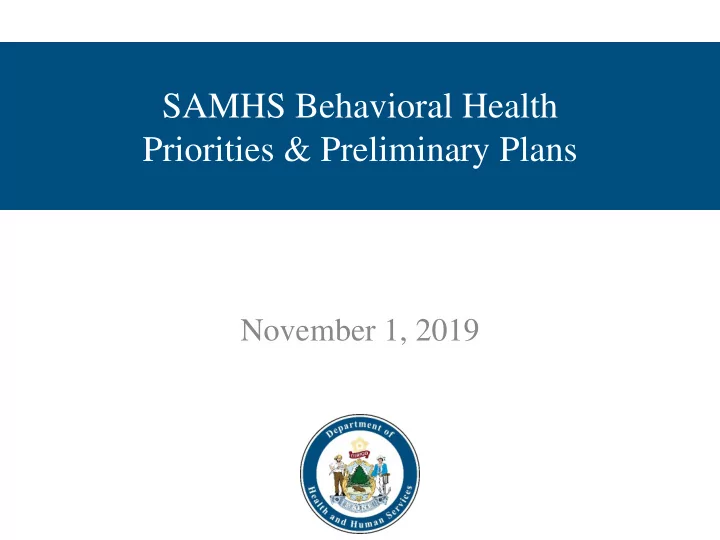

SAMHS Behavioral Health Priorities & Preliminary Plans November 1, 2019
Demand in Maine: Mental Illness • 5.3% of all Maine adults (~56,000) have Serious Mental Illness (SMI) – Higher than the national average of 4.2% • 54.9% of Mainers, on average, are in some kind of treatment for any mental illness – Higher than the national average of 42.7% • 63.5% of Mainers reporting improved functioning from treatment – Lower than the national average of 70.9% Source: SAMHSA, Center for Behavioral Health Statistics and Quality, National Surveys on Drug Use and Health, 2010 – 2011 to 2013 – 2014 2 Maine Department of Health and Human Services
Demand in Maine: Substance Use Disorders • ~64,000 (6.4% of adults) reported heavy alcohol use • ~30,000 (2.6% of age 12+) dependent on or abused illicit drugs w/in year prior • 91.4% meeting criteria for alcohol abuse/dependence did not receive treatment Source: SAMHSA, Center for Behavioral Health Statistics and Quality, National Surveys on Drug Use and Health, 2010 – 2011 to 2013 – 2014 3 Maine Department of Health and Human Services
Demand in Maine Calls to 211 in the Last 12 Months Other Inpatient MH Detox Inpatient SUD SUD Outpatient DV / SA MH Medication Outpatient Manageme nt MAT Crisis Services Maine Department of Health and Human 4 Services
Treatment Locator: Connecting Supply & Demand • Single point of entry: – New Jersey: Partnered with Rutgers University Behavioral Health Care to create single-point-of-entry call line to assess patient needs using standard criteria & match patients to services • State-supported single referral platform: – Several states using proprietary system (OpenBeds) to identify & track substance use disorder and/or mental health treatment capacity & refer patients directly for treatment - currently includes: • Indiana - Indiana Addiction Treatment • Delaware • Michigan – Others partnering with contractor to develop & manage referrals – e.g. Beacon Health Options • Massachusetts - MA BH Partnership • Georgia – Some linked to state 211 system • State-developed behavioral health treatment resource lists: – Several states have developed data system to identify & track substance use disorder treatment capacity, make info available to patients/public & providers: • Kentucky: FindHelpNow KY • New Hampshire Bureau Drug & Alcohol Services: NHTreatment Locator • Connecticut Department of Mental Health & Addiction Services: CT Addiction Services Bed Availability • Washington: WA Recovery Help Line Treatment Locator – Some linked to state 211 system 5 Maine Department of Health and Human Services
Capacity (Supply) in Maine Preliminary: Mirrors Model for Children’s Behavioral Health Strategy 6 Maine Department of Health and Human Services
Next Steps • Stakeholder engagement • Develop Treatment Locator • More detailed, thorough assessment of supply & demand – Pew Project was limited – Estimate demand based on census & epidemiological data? – More detailed survey data? • Identify gaps by service type & geography • Fill in the gaps 7 Maine Department of Health and Human Services
Preliminary DHHS Plan Strategies Outcomes SHORT TERM (2020-2021) Evaluate Assertive Community Treatment service fidelity Access to timely and Evaluate integration of behavioral health homes and other services appropriate level of Expand DDPC, recovery residences, supportive housing, PNMIs services Secure Medicaid Substance Use Disorder waiver for young families Pilot and implement treatment locator Create real-time capacity tracking system Care in least restrictive Explore Crisis Center / medication management program settings Assess expansion of early intervention services Improve provider contract process Create forensic behavioral health team Effective diversion and LONG TERM: Explore/Examine (2022-2026) reduced recidivism rates Address shortages in the behavioral care workforce in criminal justice system Explore Medicaid Serious Mental Illness (SMI) waiver Improve MH/SUD crisis services 8 Italics indicate ideas still under review Maine Department of Health and Human Services
SAMHS Multipronged Framework • Support – Workforce development – Training & Technical Assistance – Address barriers to service delivery • Expand – Increase existing service capacity ($2 million SUPPORT ACT grant) – Add components missing from service array • Accountability – Clear inclusion/exclusion criteria – Improve data integrity, collect measures that matter – Consistently share actionable information with providers 9 Maine Department of Health and Human Services
Recommend
More recommend